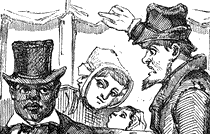Materials and Preparation
Note: Before the lesson, divide students into Home and Expert Groups. Students begin in their Home Groups, and return to Home Groups for debriefing. Members of Home Groups should be also be assigned equally to each of the three Expert Groups. Each Expert Group will "attend" a different session of the 1898 Afro-American Council Meeting. (See Jigsaw Lesson Plan Guide for more information.)
Photocopy tickets to the three sessions so that each student has one ticket.
Create a Council Packet for each student containing:
- a ticket
to a specific session.
- a Jigsaw group assignment (See Jigsaw Lesson Plan Guide).
- a Learning Guide for the Council Meeting sessions:
- Segregation and Violence;
- Solving the Race Problem; and
- Contributions to the Nation.
- a Planning Guide for the 1953 African American Council Meeting.
Top of Page
Procedure
Introductory Activity (15 minutes)
Divide students into Home Groups prior to activity.
Tell students that the National Afro-American Council
met in Washington, D. C. in 1898, to consider the status of the race at the turn of the century. Using African American Perspectives: Pamphlets from the Daniel A.P.Murray Collection, 1818-1907, students will simulate attendance at this Council meeting. Although this collection does not include the actual speeches made at the meeting, it offers similar voices, ideas, and concerns. Students will "attend" one of the three sessions of the meeting: Segregation & Violence; Solving the Race Problem; or Contributions to the Nation.
-
Students receive packets similar to conference materials they might have received if they had attended this meeting.
-
As a class, students complete the "K" column of a K - W - L
chart focusing on their prior knowledge of African-American life experiences
at this time. (See K - W - L
Lesson Guide.)
-
After completing the chart, the teacher, either on the board or overhead, will help students compile a master list of information the class has already learned about the African-American condition at the turn of the century.
-
The class will brainstorm additional themes and ideas they need to understand the topic and write these in the "W" column of the K - W - L
Activity One - Attend the 1898 National Afro-American Council (1 Day)
- Divide students into three Expert Groups as noted on the tickets:
- Segregation and Violence
- Solving the Race Problem
- Contributions to the Nation
- Have students log on to the lesson (http://learning.loc.gov/learn/lesson97/crow/crowhome.html). From the Student Activities Guide, they may click on their ticket to take them to their session.)
- Students should read the documents listed for their session and complete the section of Learning Guide for their session.
- Groups reform into Home Groups. Home Groups should have members from each of the Expert Groups. Home Groups discuss observations from the on line study, debriefing each other about the sessions and completing the Learning Guide for all sessions.
Activity Two - Research American Memory (1 Day)
Tell students that they are now going to plan the 1953
National Afro-American Council meeting to consider the status of the race at mid-century. They will research the topic of their 1898 conference session, looking for more recent data on their topic for discussion at the 1953 meeting.
-
Students reform Expert Groups based on their tickets.
- In their Expert Groups, each student locates two to three items that support the session topic. Resource Guides (one for each Expert Group) provide selected American Memory collections and other resources on the topic to start the research process.
Student Resource Guides:
- Each Expert Group evaluates resources found by members of the group, selecting 2-3 items that together provide a comprehensive overview of the topic. Groups complete the Planning Guide: 1953 Afro-American Council Meeting with resources related to their session, identifying print materials and Internet sites using appropriate citation guidelines. Students should print a copy of the on line resources.
Activity Three - Synthesis of Convention (1 Day)
- The Expert Groups meet to examine items they've evaluated and selected and plan a short council meeting session related to the group theme.
- Groups can develop a storyboard, post items on a school Internet site or print copies for classroom display.
- Each group "attends" the other two sessions of the 1953 National Afro-American Council meeting created by the class.
Top of Page
Evaluation and Extension
The teacher needs to continuously monitor student progress
with attention to technical skills, understanding, and focus of the student activity. Various techniques can be incorporated for assessment as the
teacher deems necessary.
As students complete each activity, they place their Learning Guides and printed copies of each item in their Council Meeting packet. At the conclusion of the unit, the Council Meeting packet will be collected by the teacher for evaluation as a mini-portfolio of the student's experience throughout the unit.
|




